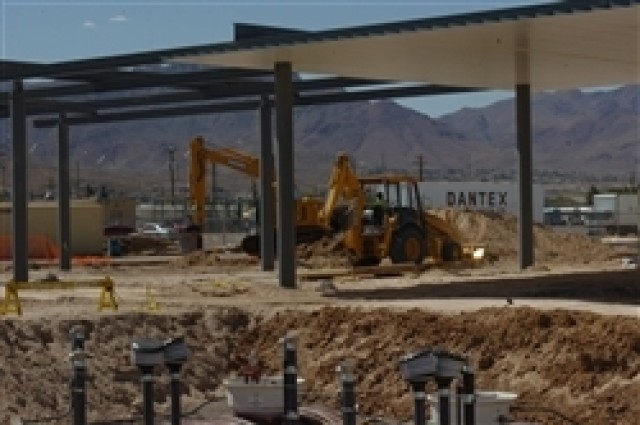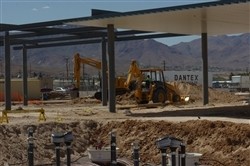FORT BLISS, Texas, Dec. 6, 2006 - Bases slated to grow as a result of the Base Realignment and Closure process need look no farther for lessons learned than this sprawling post that's tripling its population and transforming from an air-defense center to an armor center.
Even before the ink had dried on the BRAC 2005 recommendations, Fort Bliss was already preparing to welcome about 20,000 1st Armored Division soldiers and 27,000 family members relocating from Germany, Clark McChesney, director of the post's Transformation Office, told American Forces Press Service.
That plan, part of the Defense Department's global reposturing strategy and the Army's modularization effort, calls for the 1st Armored Division headquarters, four brigade combat teams and a combat aviation brigade from Fort Hood, Texas, to move to Fort Bliss within the next five years. Meanwhile, the Air Defense Artillery Center and School is slated to move from Fort Bliss to Fort Sill, Okla., during the next four years.
Post planners anticipated big growth for the post long before they were formally announced and began laying the initial groundwork for it more than 20 years ago, said Jean Offutt, the post's public affairs officer.
As a result, she said, Fort Bliss is at the leading edge of the sweeping changes under way at other posts around the country and is being looked to by many as a model for growth.
"I was told by the people in Washington that whenever anybody wants to know anything about how to do something or they need a briefing about it, they call Fort Bliss to come and tell them," Offutt said.
McChesney compared planning to boost the post's soldier population from 10,000 to about 30,000 to putting together a puzzle in which all the pieces are the same size and color. "We're trying to figure out how to put the puzzle together here at Fort Bliss," he said. "And I expect that a lot of our other sister installations around the United States are doing the same thing."
Complicating the process, he said, is the fact that the Army is at war, and changeable deployment schedules leave big question marks as to exactly what units will be moving both to and from the post and when.
"I like to talk about this like it's dominoes," he said. "Somebody has to be the first domino to fall. And that first domino has to fall because someone has to move off of Fort Bliss in order to create a vacancy in facilities so that there is a place for that next person to move in."
Some of the first units slated to leave Fort Bliss departed this summer, opening up space for the first incoming units, including the new, high-tech Future Force Integration Directorate.
But even as post officials tweak their planning, the first of the incoming soldiers, the 1st Cavalry Division's 4th Brigade, began arriving in October 2005. The brigade moved into temporary modular facilities but will relocate to permanent facilities when $2.5 billion in construction at Fort Bliss wraps up in 2014, McChesney said.
Post officials broke ground Oct. 23, beginning a six-year construction boom that will transform stretches of mesquite brush and sand dunes on the post's eastern side into state-of-the-art living and training facilities. "We're basically building an entire new city," McChesney said.
Ultimately, the expansion will include new headquarters and administrative spaces, aircraft hangars, arms rooms, unit storage facilities, barracks, dining facilities, fitness centers, medical and dental facilities, motor pool areas, maintenance facilities and wash racks.
Plans also call for $180 million in construction to expand the range complexes, which now serve air defense units, so they're suitable for mounted maneuvers. The expansion plans will tap into the space and capabilities at White Sands Missile Range, N.M., collectively offering 800,000 acres of on- and off-road maneuver area, McChesney said.
"We are going to end up with three major range complexes when this is all done," he said, allowing four combat brigades and a division to conduct everything from individual-soldier training to brigade-level operations.
These new range facilities will enable soldiers "to go out and conduct realistic training that meets their requirements so that they are prepared when they go into combat with the best training facilities that we have to give them," McChesney said.
The Fort Bliss expansion plan also includes a full range of quality-of-life and family-support facilities and programs, too. That includes about 600 new homes, a number McChesney said could increase to about 1,700 depending on results of a local housing analysis. "What the housing market analysis is going to try to do is ... determine what is the capability of El Paso to absorb this growth, and then how much does the Army have to make up'" he said.
Plans also call for new child-care facilities, shopping areas and other quality-of-life activities. "All of those things have to grow to keep up with the population," McChesney said. "You can't just build facilities for soldiers to live in. You also have to be concerned about their quality of life."
Because the post is smack in the middle of El Paso, one of Texas' biggest cities, which is experiencing its own population boom, Fort Bliss planners are working closely with state and local officials to ensure it's the base's growth is a success. "This has really been a huge partnership. ... And one of the real significant lessons learned is that you have to be partners with the folks downtown," McChesney said.
That includes not just the city and county government, but also five local school systems expected to absorb about 9,600 school-age children from Fort Bliss, business developers, homebuilders, realtor associations and transportation officials, among others.
The Texas Department of Transportation is looking at building a $300 million high-speed "inner loop" roadway to support Fort Bliss, and local officials are considering building a community college on the installation, McChesney said.
When the expansion is completed and all the new units have arrived, Fort Bliss will transform back to its historical cavalry roots. The post was originally established to protect the Butterfield Trail and other trade routes, and the 1st Cavalry Division stood up here in 1921, Offutt said. When it relocated here in 2005, the 1st Armored Division's 4th Brigade was returning to its birthplace, she said.


Social Sharing